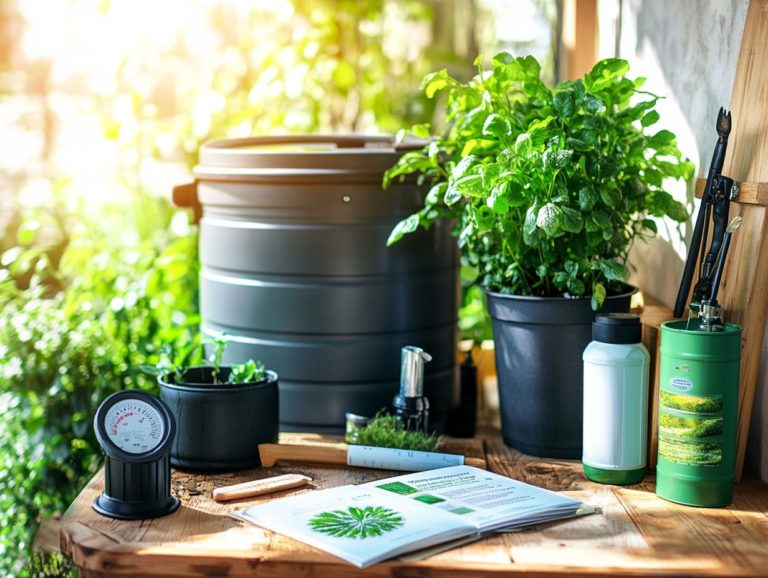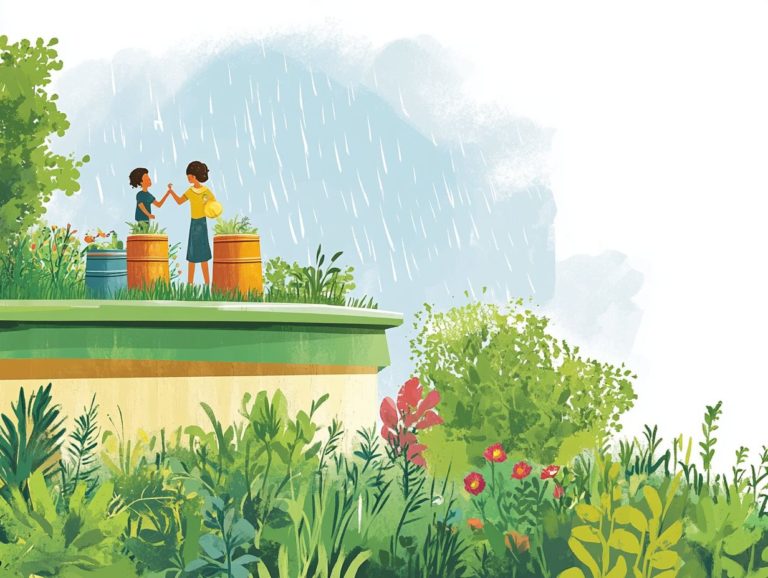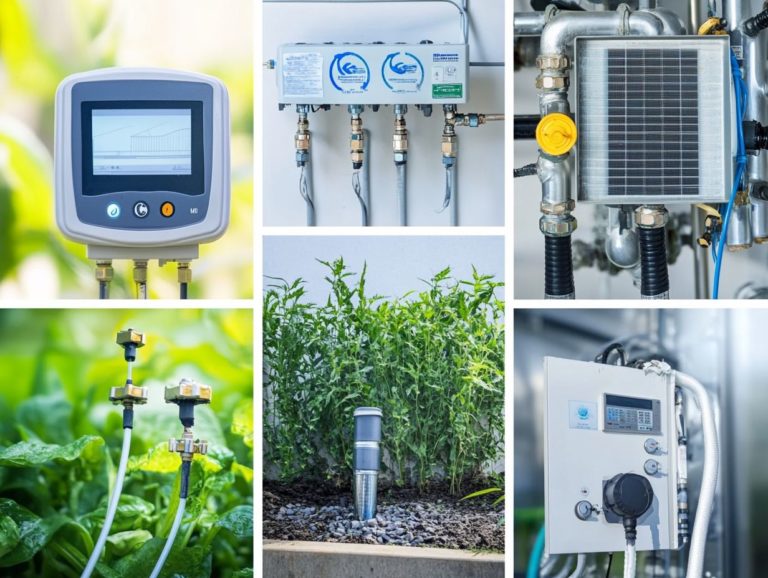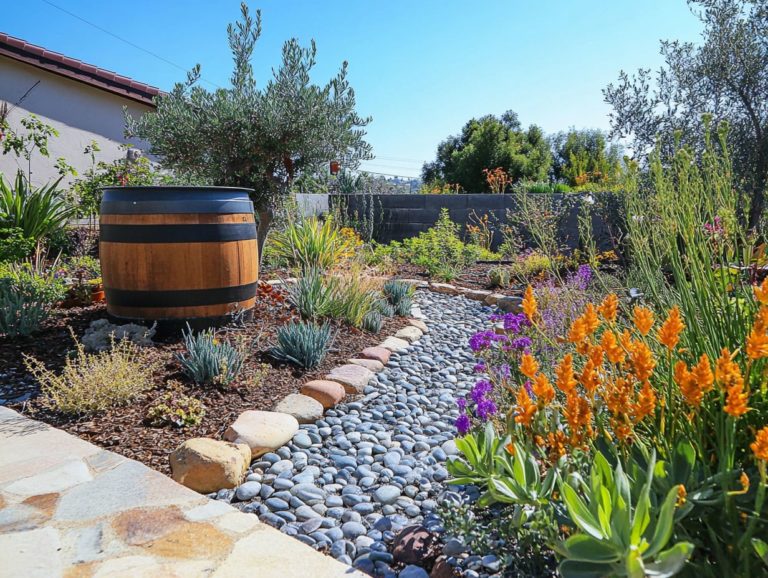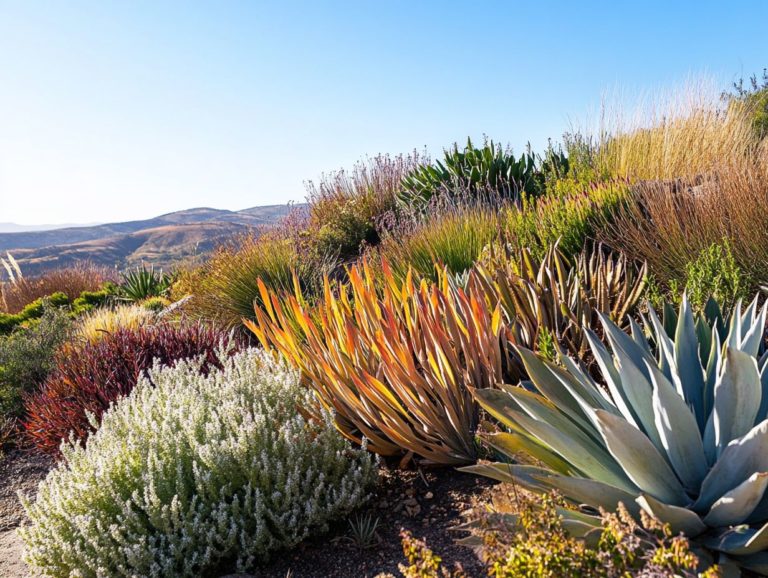Why You Should Consider Water-Efficient Landscaping
Water-efficient landscaping transcends mere trendiness; it is a crucial practice that benefits both the environment and your finances.
In an era grappling with escalating concerns over water scarcity and soaring utility expenses, cultivating a landscape that conserves this invaluable resource is essential.
This article explores key strategies for designing a water-efficient garden. You will learn about selecting the right plants, implementing effective irrigation systems, and embracing sustainable maintenance practices.
It also addresses common challenges you might encounter, guiding you in creating a flourishing, eco-friendly outdoor space. Discover how you can positively impact while enhancing the beauty and functionality of your landscape!
Contents
- Key Takeaways:
- The Importance of Water-Efficient Landscaping
- Designing a Water-Efficient Landscape
- Choosing the Right Plants for a Water-Efficient Landscape
- Implementing Water-Saving Techniques
- Maintaining a Water-Efficient Landscape
- Overcoming Challenges and Obstacles
- Frequently Asked Questions
- What is water-efficient landscaping?
- Why should I consider water-efficient landscaping?
- How does water-efficient landscaping save money?
- What are some examples of water-efficient landscaping techniques?
- Is water-efficient landscaping difficult to maintain?
- How does water-efficient landscaping benefit the environment?
Key Takeaways:
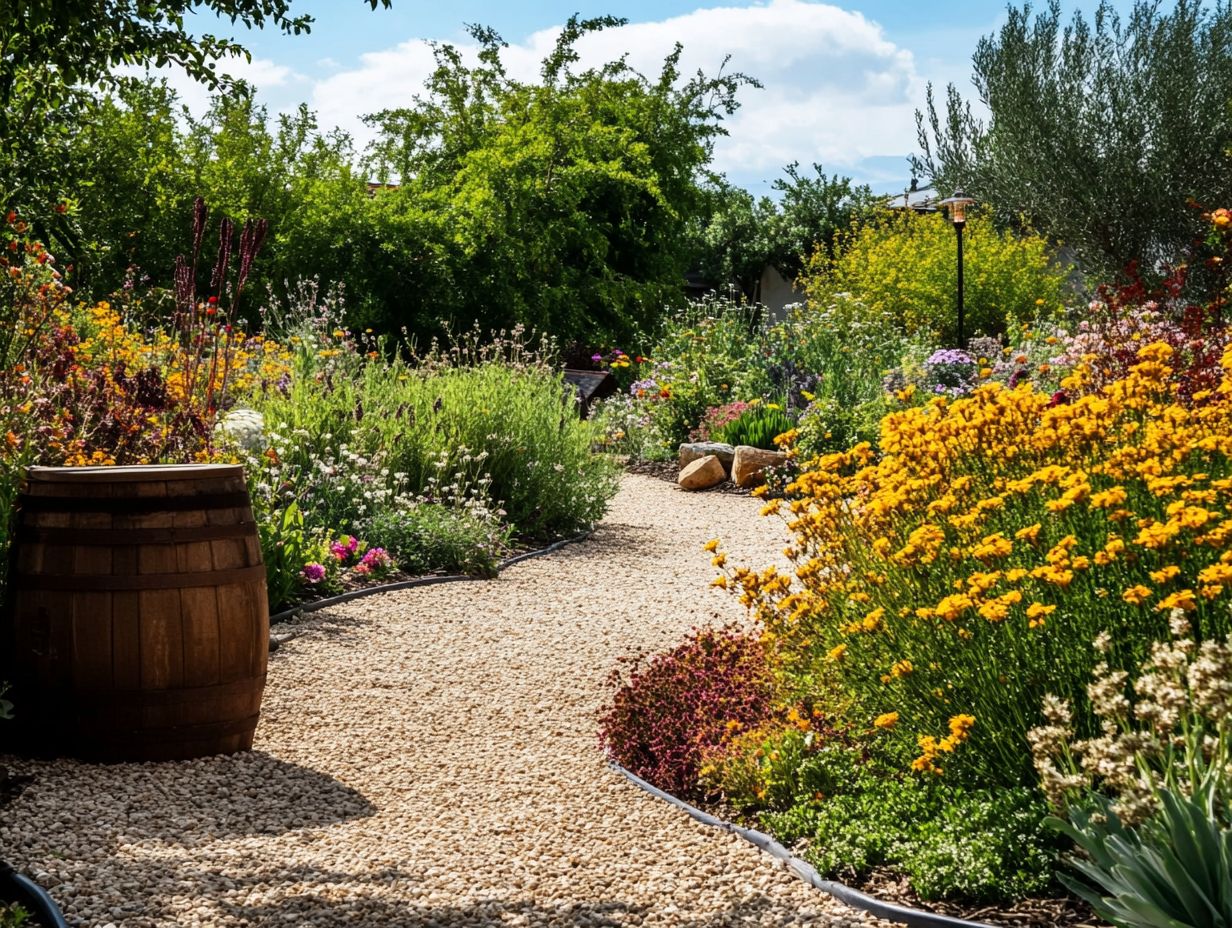
- Save money and help the environment by choosing water-efficient landscaping for your outdoor space.
- Use native and drought-resistant plants for a beautiful, sustainable garden.
- Proper maintenance and water-saving techniques, like efficient irrigation systems, ensure your landscape’s long-term sustainability.
The Importance of Water-Efficient Landscaping
Water-efficient landscaping is essential for homeowners seeking to elevate their property while supporting environmental sustainability.
By integrating design techniques that emphasize water conservation and using native plants, you can significantly reduce your water consumption, lower your water bills, and enhance your home s curb appeal.
This approach nurtures a healthier ecosystem and offers economic advantages through decreased maintenance costs and substantial water savings.
It’s a wise investment for both your finances and the planet.
Environmental and Financial Benefits
The environmental and financial advantages of water-efficient landscaping are remarkable, leading to reduced water bills and a smaller carbon footprint.
By embracing these sustainable practices, you not only enjoy immediate financial benefits from lower water consumption and maintenance costs, but you also make a significant impact on local ecosystems.
Water-efficient landscaping fosters biodiversity by creating habitats for various plant and animal species. It effectively manages stormwater runoff, promoting healthier waterways.
This approach encourages responsible resource use, which lightens your monthly expenses and supports a greener planet, showcasing a balance between economic savings and environmental stewardship.
Designing a Water-Efficient Landscape
Designing a water-efficient landscape requires embracing smart design principles that prioritize sustainability without sacrificing aesthetic appeal.
By implementing landscaping methods that reduce water use and efficient irrigation systems, you can create a stunning outdoor space that conserves water while supporting local biodiversity.
This approach boosts both your plants and your property s value.
It s an attractive option for anyone keen on minimizing their environmental impact.
Key Elements and Strategies
Key elements and strategies for achieving a water-efficient landscape include thoughtful plant selection, advanced irrigation controllers, and using mulch and rainwater harvesting techniques.
By choosing drought-tolerant plants, you can significantly cut down on water usage while crafting a vibrant garden that flourishes even in arid conditions.
Smart irrigation systems, like drip irrigation and precise timers, ensure that water is delivered exactly where and when it s needed, minimizing waste.
Utilizing mulch around your plants conserves moisture by reducing evaporation and suppresses pesky weeds that compete for water.
Implementing rainwater harvesting systems provides a sustainable irrigation source and promotes eco-friendly practices, transforming your landscape into a beautiful, resilient, and resource-efficient oasis.
Choosing the Right Plants for a Water-Efficient Landscape
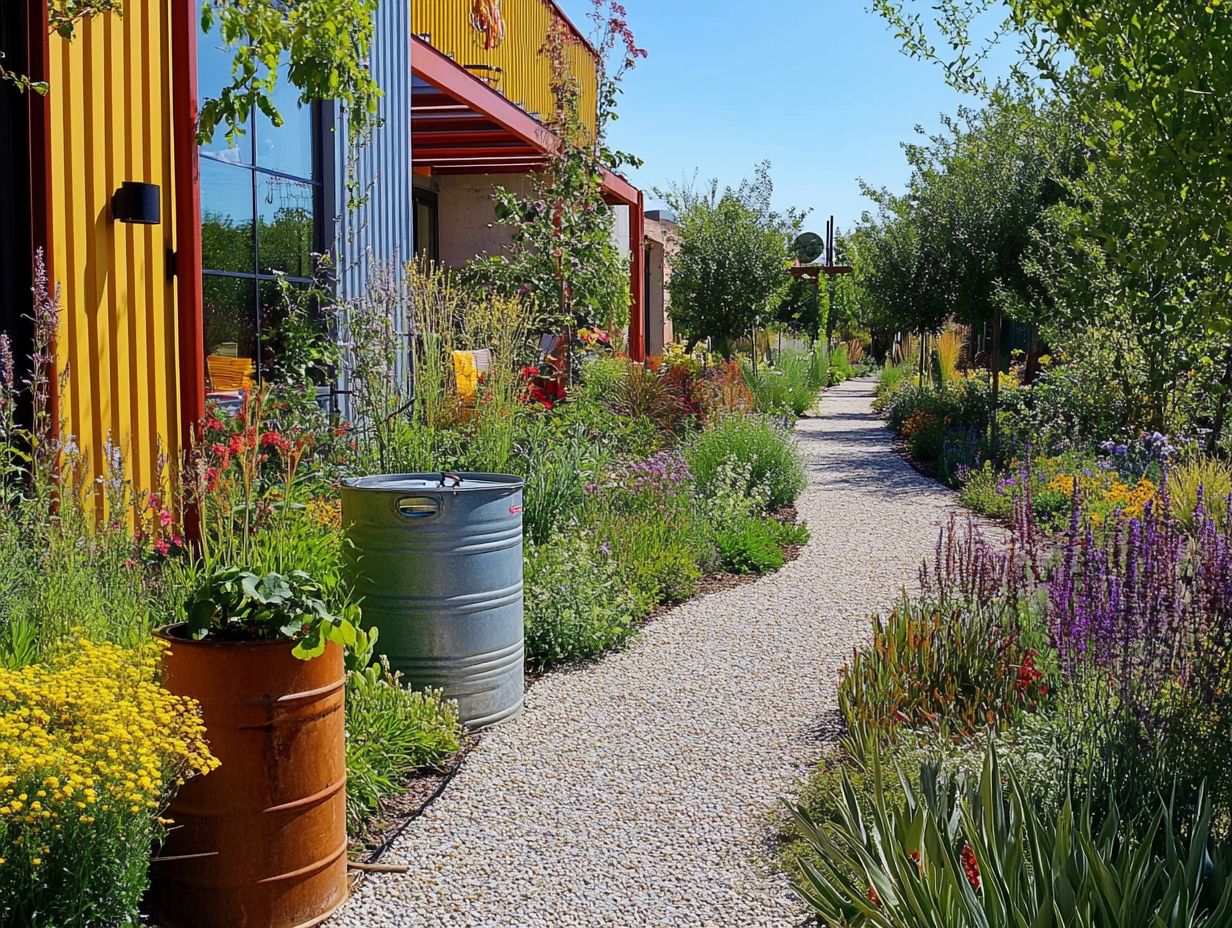
Selecting the right plants is crucial for crafting a successful water-efficient landscape. Opting for native and drought-resistant varieties conserves water and enhances biodiversity.
These choices require less irrigation and foster environmental sustainability by offering vital habitats for local wildlife. Prioritizing plants that align with the local climate helps create a thriving landscape with minimal maintenance and resource use.
Native and Drought-Resistant Options
Native and drought-resistant options are essential for creating water-efficient landscapes. They are better suited to local climates and require significantly less water for upkeep.
These plants thrive in various environments and enhance local ecosystems. Incorporating native species like wildflowers, shrubs, and grasses creates vibrant spaces that attract pollinators, boosting biodiversity.
Drought-resistant varieties, like succulents and native perennials, add aesthetic charm while minimizing water usage. Their resilience makes them perfect for arid regions with limited rainfall. Including these plants promotes sustainable practices, ensuring your garden flourishes without straining precious water resources.
Implementing Water-Saving Techniques
Utilizing water-saving techniques is vital for homeowners who want to optimize their landscape s water use while enjoying a vibrant outdoor space.
Efficient irrigation systems, climate-based controllers, and rainwater harvesting practices significantly enhance water efficiency. These methods minimize water waste and ensure every drop counts during challenging drought conditions.
Irrigation Systems and Other Methods
Systems that water your plants and efficient controllers are essential for promoting water conservation in landscaping.
With various options available, from drip systems delivering water straight to plant roots to sprinkler systems covering larger areas, you’ll find the perfect fit for your landscape.
Each type of irrigation system has distinct advantages, including reduced water waste and enhanced plant health. Evaluate your area’s specific needs before making a choice.
Consider factors like soil type, climate, and plant selection; these elements are crucial for determining the best outdoor watering strategy. This creates a sustainable environment that conserves precious water resources.
Maintaining a Water-Efficient Landscape
Maintaining a water-efficient landscape requires your regular attention to sustainable practices that promote healthy soil and effectively meet your plants’ water needs.
Regular inspections of your irrigation systems, applying mulch to retain soil moisture, and adjusting maintenance routines all contribute to optimal plant health.
Embracing these strategies helps sustain a flourishing water-efficient landscape while minimizing chemical use and enhancing biodiversity.
Tips for Long-Term Sustainability

Implement these maintenance tips for lasting health and to minimize chemical use while preventing pest infestations in your water-efficient landscape.
Embrace organic practices like inviting beneficial insects into your garden and using companion planting to cultivate a balanced ecosystem that naturally wards off pests. Monitoring your plants’ health and soil conditions is essential; catching issues early allows for timely interventions without harsh chemicals.
Incorporating mulching and selecting native plants helps retain moisture and enriches the ecosystem while reducing overall water usage.
By adopting these strategies, you ll safeguard the health of your landscape and contribute positively to the environment, ensuring future generations enjoy the beauty and bounty of a well-tended garden.
Overcoming Challenges and Obstacles
It’s essential to overcome the challenges of water-efficient landscaping. This includes varying climate conditions and different soil types.
You must adapt your strategies to tackle water scarcity and pest issues. Use methods that work well with your local environment.
By understanding the unique challenges of your landscape, you can create resilient outdoor spaces. These spaces will not only endure but also flourish, even in tough conditions.
Dealing with Climate and Soil Conditions
Understanding climate and soil conditions is crucial for effective water-efficient practices. This knowledge helps you choose plants and irrigation systems that thrive in your setting.
Assessing the local climate allows you to identify native plant species that need less water. These plants also support local wildlife.
Analyzing soil composition helps you select the right soil conditioners. This ensures your plants develop strong root systems.
Exploring drought-resistant plants and efficient drip irrigation can significantly reduce water usage. This makes your landscaping sustainable while beautifying your outdoor spaces.
A thorough evaluation of climate and soil empowers you to make informed decisions that align with responsible environmental practices.
Frequently Asked Questions
What is water-efficient landscaping?
Water-efficient landscaping is designed to save water and reduce usage. You can achieve this by using plants and materials that require less maintenance.
Why should I consider water-efficient landscaping?
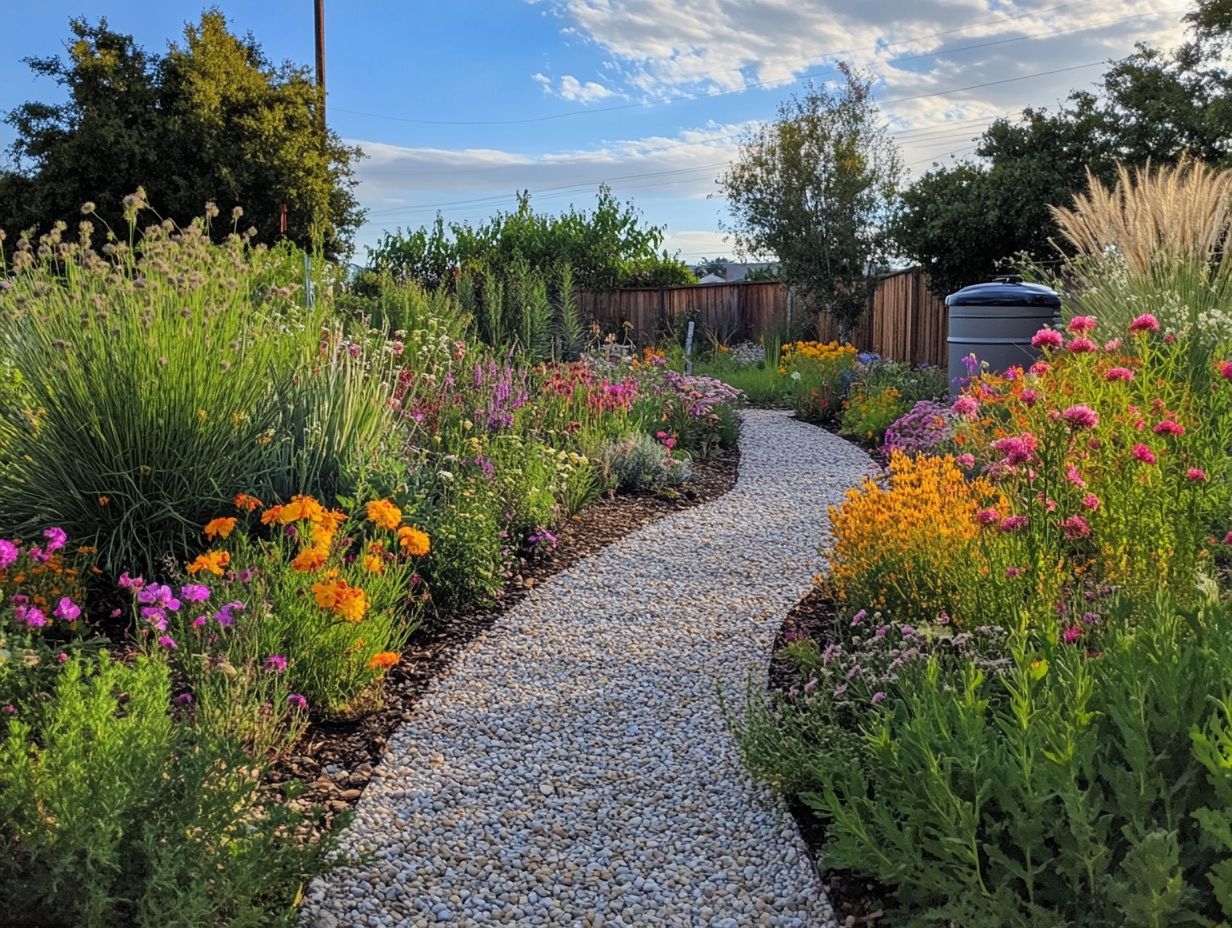
There are many reasons to consider water-efficient landscaping. It saves money on your water bill, conserves resources, and reduces your environmental impact.
Plus, it can make your property look great and boost its value!
How does water-efficient landscaping save money?
Water-efficient landscaping saves money in many ways. By using drought-resistant plants and efficient irrigation systems, you lower your water usage and bill.
It also requires less maintenance, so your landscaping costs decrease.
What are some examples of water-efficient landscaping techniques?
Examples include using native plants, incorporating mulch and rocks to retain moisture, and installing drip irrigation systems. Grouping plants with similar water needs is also effective.
Is water-efficient landscaping difficult to maintain?
No, it can be easier to maintain than traditional landscaping. By choosing plants suited to your climate, you reduce the need for frequent watering.
It may also require less mowing and trimming, saving you time and effort.
How does water-efficient landscaping benefit the environment?
Water-efficient landscaping conserves water, a precious resource. It also reduces the need for chemical fertilizers and pesticides that can harm wildlife.
By using native plants, you support local ecosystems and enhance biodiversity.

